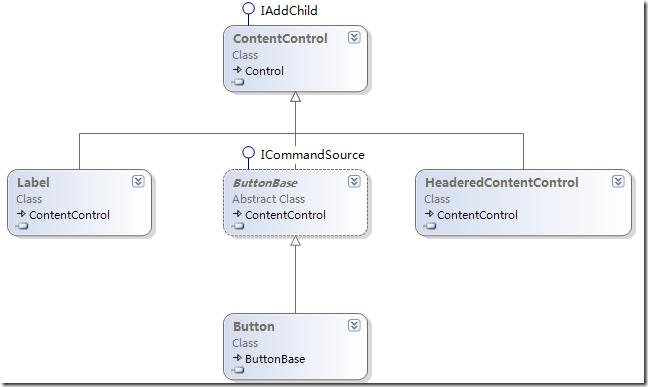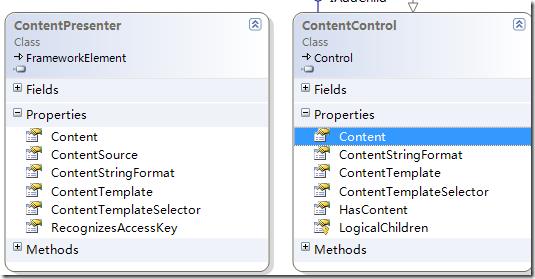ContentPresenter理解
Posted 山涧清泉
tags:
篇首语:本文由小常识网(cha138.com)小编为大家整理,主要介绍了ContentPresenter理解相关的知识,希望对你有一定的参考价值。
这是2年前写了一篇文章
http://www.cnblogs.com/Clingingboy/archive/2008/07/03/wpfcustomcontrolpart-1.html
我们先来看MSDN对其的介绍
Displays the content of a ContentControl
似乎其是为ContentControl定身量做的.
为了理解这一点,首先我们要对WPF内容模型有所了解,上面这篇文章有提到过ContentControl继承自Control,多了Content属性,继承自ContentControl的均可以称之为内容模型的控件.如下
这里似乎看不到ContentPresenter的影子.下面来举一些例子
一个ContentPresenter的例子
ContentPresenter可以直接在xaml中输出,其视觉树中包含一个TextBlock,在默认的WPF样式定义中找不到任何关于ContentPresenter的样式,说明了ContentPresenter并非是真正代码逻辑与样式分离的,而是在内部代码中提供了一个默认的模板即呈现了TextBlock,如果在内部创建模板的话,一般均会采用FrameworkElementFactory创建根元素,但这种方式太过于复杂,适用于一些简单默认操作,就如ContentPresenter内部的TextBlock.
那么问题出来了,为什么不直接用TextBlock呢,还要包装一个ContentPresenter?
ContentPresenter与TextBlock
如要回答上面的问题,那么就犹如来讨论两者的区别,我们来看下TextBlock
<TextBlock Text="Hello"/>
TextBlock是一个真正以文字为主题的元素,而ContentPresenter的功能就不只呈现文字了(只补)
只不过默认是呈现文字而已,但两者概念完全不同,Content属性是object类型,而非string,可以自己以Content为数据源而重新定义模板(ContentTemplate),如下示例
这样的话ContentPresenter将不再局限于文字的呈现.
下面来看看ContentControl与ContentPresenter的关系
ContentControl与ContentPresenter
先看一个被重新定义的的Button样式
上面可以看到,使用ContentPresenter非常的方便,只要将ContentPresenter放在模板中即可,也不需要做任何的额外的绑定(难道不需要做吗?只不过ContentPresenter内部帮我们做了默认的绑定),但如果使用TextBlock呢?如下还是需要做绑定的
<Style TargetType="Button">
<Setter Property="Template">
<Setter.Value>
<ControlTemplate TargetType="Button">
<TextBlock Text="{TemplateBinding Content}"/>
</ControlTemplate>
</Setter.Value>
</Setter>
</Style>
如上看来我们还不如说ContentControl是ContentPresenter的一个特例,而ContentPresente
ContentPresenter则是ContentControl的基础.为了适配ContentPresenter,ContentControl提供了内容模型的相关属性,本质上ContentPresenter并非仅仅只是用到ContentControl而已,ContentPresenter可以通过指定ContentSource来绑定指定的源属性
记住内容模型不仅仅只是呈现文字而已,如果只是为了呈现文字的话,是不需要ContentPresenter的
父子元素之间的关系(ItemsPresenter)
有时候控件并非维护本身逻辑,而是依赖于父子元素的,如了上诉的ContentPresenter,我们还有一个非常常用的ListBox控件,因为继承自ItemsControl,所以有一个ItemsPanel属性作为集合元素承载容器,但集合控件本身却不负责呈现控件,那么这个任务就留给了子元素ItemsPresenter,其实用也很简单,只要把ItemsPresenter放在内部模板中,那么ItemsPresenter则会去检测父元素是否为集合控件,然后将ItemsPanel添加到其内部视觉树当中
<Style x:Key="{x:Type ItemsControl}"
TargetType="{x:Type ItemsControl}">
<Setter Property="Template">
<Setter.Value>
<ControlTemplate TargetType="{x:Type ItemsControl}">
<Border Background="{TemplateBinding Background}"
BorderBrush="{TemplateBinding BorderBrush}"
BorderThickness="{TemplateBinding BorderThickness}"
Padding="{TemplateBinding Padding}"
SnapsToDevicePixels="true">
<ItemsPresenter SnapsToDevicePixels="{TemplateBinding SnapsToDevicePixels}"/>
</Border>
</ControlTemplate>
</Setter.Value>
</Setter>
</Style>
如下视觉树,StackPanel作为ItemsControl的默认容器
先到这里吧
以上是关于ContentPresenter理解的主要内容,如果未能解决你的问题,请参考以下文章






